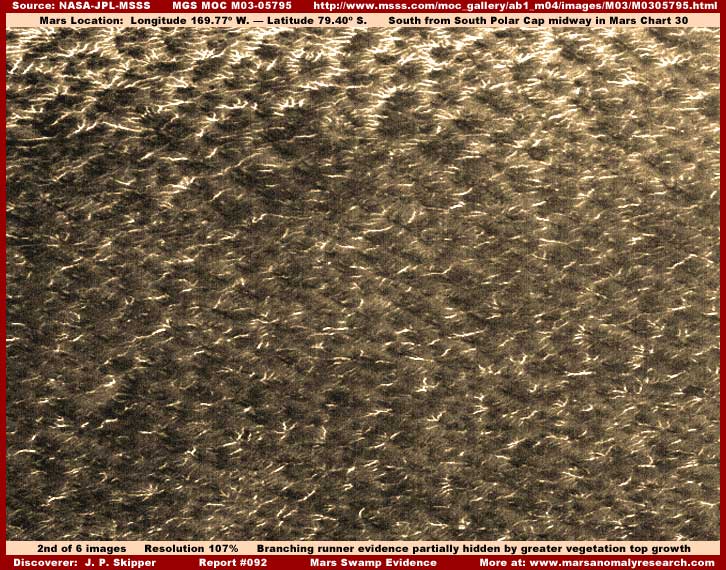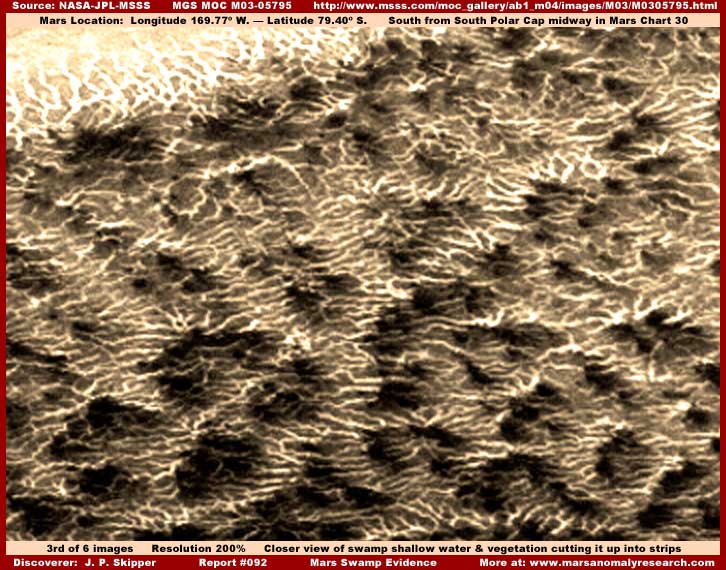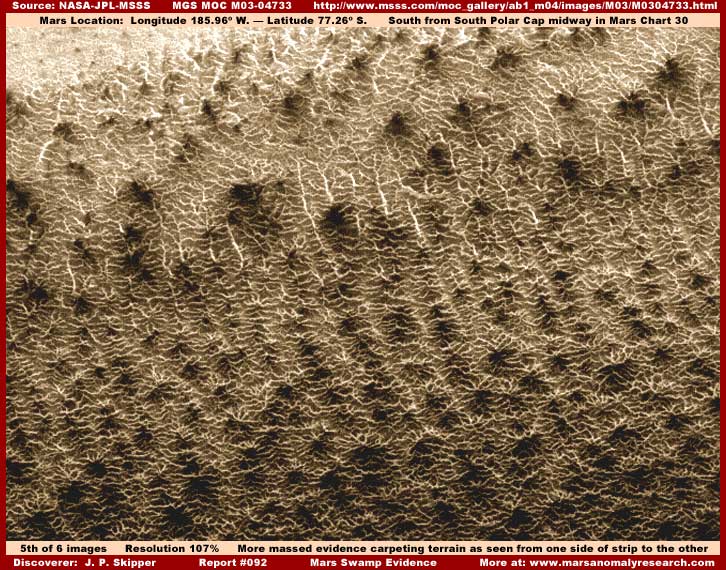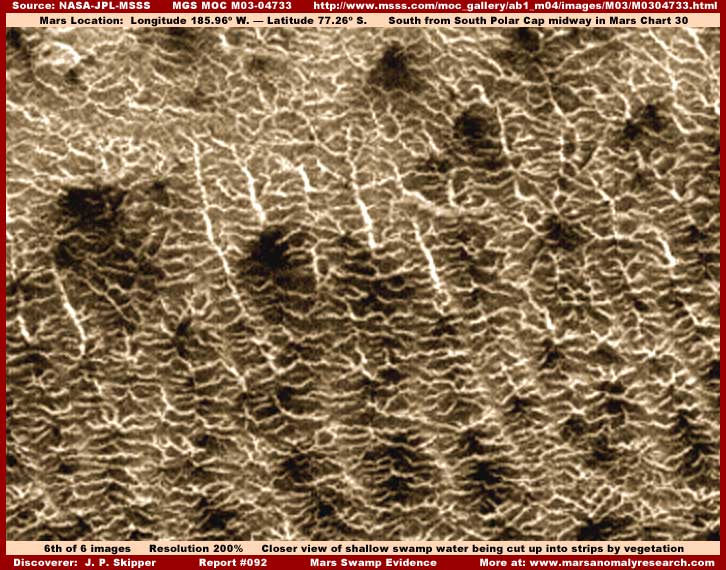
MARS SWAMP EVIDENCE
Report #092
September 11, 2005

In my last two Reports #090 and #091, I've shown evidence of biological forest life on Mars so clear, straightforward, and in one's face that it is really hard to ignore or misinterpret. Added was some interesting separate surface water evidence as well. This report will be different. At first glance the evidence appears strange and unfamiliar to the Earth human eye and will be more difficult to interpret because of that. Here you're going to see incredible hard to accept surface water and biological plant life intermingling as opposed to water being in one place and vegetation being nearby adjacent to it. So, if the science and academic communities fail to recognize this evidence for what it is, that will be understandable, at least to a degree.
As you can see in the above M03-05795 strip based first image from a site midway out in the South Polar Region, this strange looking Mars evidence is characterized by what appears to be a lot of patches of fairly evenly distributed dark solar light absorbing spots with many highly light reflective narrow runners appearing to sort of branch and radiate out from these darker areas that then mingle with adjacent evidence doing the same thing. The initial visual observation and perception is a strange dense uniform but somewhat confusing tangle of this evidence.
However, note that this tangle evidence engulfs and hides the true light reflective terrain. A sample of that true light reflective terrain can be seen in the upper left corner of the image. What must first be understood is that the view here is much more distant than the initial impression. The eye wants to insist that this view is closer than it actually is and this in turn wants to influence the perception that this may be kind of strange vegetation in the darker spots with light color highly reflective branching runners radiating off from each darker patch. This first impression was my own initial interpretation until much closer examination revealed more.
The darkest patches are in fact very distantly seen taller vegetation too distantly viewed to see any real detail of it except for its darker color. The darkest spots are essentially and even literally islands of larger established vegetation. What is less obvious is that there are many much lower height strips of also dark vegetation extending out over shallow water that in turn divides that shallow water up into a great many light color highly reflective narrow strips that look like branching runners in this very distant imaging. So this is a mix of probably lower height aquatic and semi-aquatic vegetation reaching out into shallow swamp water conditions and attempting to bridge between the dark islands.
As is often the case when darker and sharply contrasting lighter color visual components are present mixed together fairly equally in a scene, the lighter color more light reflective components tend to dominate the observing eye and the darker components are visually diminished in the perception process. Regardless of the visual gymnastics and even though it at first may not look like it, this scene is a story of higher and lower level vegetation forest flourishing in a swamp shallow liquid surface water setting.

The above second image from the same strip is a scene right below that in the first image with a slight overlap between the two. It demonstrates the differences in this evidence between the adjacent and overlapping evidence image areas. Here in this scene you can see that the darker more light absorbing evidence is flourishing even more and covering over and hiding a greater percentage of the highly light reflective evidence but not enough to hide it completely. This of course demonstrates active, dynamic, aggressive, changing growth behavior typical of vegetation life evidence as opposed to inanimate geological evidence.
In other words, although this evidence's visuals may be rather unfamiliar to the human eye, we are looking at a dark solar light absorbing forest of vegetation life. In this second image scene, it has covered over much more of the highly light reflective water evidence, although still only partially. Note that the combination of the darker light absorbing vegetation and the shallow swamp surface water has in turn completely covered over any underlying terrain geology hiding it from view.
For recognition of the true look of the geological terrain, again note the much more light reflective terrain in the upper left portion of the first image here. This area at least demonstrates what the true geology in this area looks like in this poor quality distant satellite imaging as released to us and how it compares visually to this more dynamic darker color life evidence covering it.


The above 200% third image and below that 300% fourth image without my image frame provides a closer and closer but still distant view of the swamp life and water evidence seen in the first and third image. Careful examination of this scene begins to reveal that the many light color light reflective narrow strip evidence so dominate to perception in the more distant views is actually defined and outlined by smaller dark strips and islands. The darker strips and islands better seen in the closer views are you will note darker than the true light reflective terrain evidenced in the upper left corner of the first image and almost certainly represents vegetation of a lower height variety as opposed to the larger darkest patches they often extend out from.
In these still too distant and poor resolution closer views, I'm satisfied that we are looking at difficult to recognize shallow water saturated swamp land here. The brightest light reflective surfaces are the liquid and the darker surfaces are solar light absorbing vegetation the details of which cannot be adequately seen due to the distant limited resolution. Where lower growing more aquatic or semi-aquatic vegetation is able to establish itself in this shallow swampy depression area, it grows into denser broken irregular clumps that eventually over time builds up ground under them higher until finally out of the liquid and will then eventually support taller not necessarily aquatic and more land based vegetation. These latter are the larger darkest clump areas you see in these images.
The lower growing more aquatic or semi-aquatic oriented vegetation grows out advancing into the shallow liquid between the darkest clumps building upon itself and forming narrow bridge building strips and islands of itself and these eventually over time cut up what used to be broader open swamp shallow water area into just a maze of narrow bands of open water between the vegetation strips and islands. In other words, we are seeing the advancing process of vegetation retaking this natural geological depression area of shallow water much as happens here on Earth when many generations of different kinds of aquatic and then land based vegetation eventually fills in shallow depression swamp water areas over long periods of time.
Again, the reason this vegetation and liquid surface water evidence is so difficult to recognize here is because these scenes, including even the closest view scenes, are still too distant forcing already closely packed evidence to tend to merge together into a confusing maze overwhelming to the human eye. Also, the light color highly reflective strips of liquid visually dominates and subdues the darker more light absorbing scenery vegetation strips and islands to the eye. In other words, we can mostly see the visually brightest overall context information in the distant official views and less so the equally important darker component information that makes up the total scene content.
This poor quality distant view they thought adequately disguised this evidence making it too strange and confusing looking is no doubt why this particular Mars water and life evidence does not have any direct image tampering applications trying to further obscure it. Although almost successful, that turns out to be a mistake on their part and a break for us. It is through such mistakes at official level that small amounts of anomalous evidence still is able to make its way through to us in spite of the attempts to hide it.

The above fifth image is from another different strip number M03-04733. I've included its sample evidence here, even though it is redundant, to demonstrate that this Mars swamp evidence isn't just an aberration in one isolated spot and it demonstrates some variations on the same theme.
As you can see, this image has very similar evidence but there are some subtle differences. For example, here the evidence seems to be aligned along visually subdued rows angling slightly from lower right to upper left. Further, in the upper portion of the image, note what appear to be longer light color bright reflective main trunk lines extending along the same alignment angle with branching lesser bright lines clearly terminating in the main trunk lines and branching off from them.
I suspect that the highly reflective longer trunk lines represent long narrow shallow depressions with liquid in them providing the high reflectivity factor longer lines and the darker areas between these parallel running main lines represent subtle slightly higher ground with reflective liquid there also draining down into the main trunk lines. These many longer straighter narrow parallel depressions may be the result of compacted parallel subtle folds in the underlying terrain geology creating many multiple long narrow parallel depressions and the slightly higher ground between them. Note that the darker clumps tend to subtly align along the higher terrain between the depressions.
On the other hand, note the incredible tangle density and complexity of all the highly reflective lines in the lower portion of the image. This density again appears to suggest branching runners stacked on top of each other rather than depressions with liquid in them. Even so, this is an optical illusion created by too much distance where smaller detail is run together into a confusing visual maze and tangle as perceived by the human eye and the light color highly light reflective visual components tend to visually dominate and subdue the darker scene components.

The above fifth image represents a closer view of a sample portion of this second strip's evidence but once again the distance is still too great in absolute terms to resolve very much of this confusion. Even so, careful detailed examination following different samples of the light reflective line evidence demonstrates most often that they travel all the way around in an irregular meandering fashion and frequently joining back up with their selves and forming dark color independent islands and strips in the process so very typical of a self leveling fluid in shallow depression swamp conditions.
Note that the light reflective lines do not seem to correlate very readily with the darker color patches such as radiating out from them and this undermines any perception or interpretation that these are vegetation hard surface branching runners. I've already reported on patch life evidence with runners radiating out from their core areas in previous reports. In that evidence the center area of a patch is denser relative to the outer perimeter thinner edges as would be typical of the older more established center area of a living dynamically but well defined growing mass. Here in this evidence, the light reflective evidence does not radiate out from the darker clump areas so much as often just seeming to cut through them breaking them up visually as might be more typical of surface water.
The bottom line is that, although the evidence may not be as clear and in one's face as in the previous two reports, I am well satisfied that we are looking at biological vegetation life and shallow liquid surface water here in all the evidence in this report as opposed to just inanimate terrain geology. I am also well satisfied that the darker evidence represents relatively normal swamp vegetation in a mix of land, aquatic, and semi-aquatic based life and, although it is perhaps admittedly a little more difficult to recognize for what it really is, I am reasonably satisfied that we are witnessing swamp shallow liquid surface water complete with aggressive flourishing and mingling biological vegetation life conditions as seen from a great distance in this poor quality satellite imaging as released to us.
Can you imagine what it must be like down there in this wild ecosystem? One can only guess at what kind of new, different, and plentiful life forms may be flourishing down there in these distantly seen thick and flourishing swamp ecosystems on another world? Whole teams of investigating Earth scientists from different fields would no doubt be happier than a pig in, uh, well you get the picture. Just be careful when you eventually do eventually go down there scientists because I suspect there may be a cooter or two there that one really wouldn't want to meet up close and personal in wild places like this in the Mars South Polar Region.
You've got to be kidding, swamp surface water conditions and thick vegetation mixed in taking advantage of it on what is suppose to be dry as dust Mars with all that concept's many implications! Have you lost your mind? Yes, it is certainly incredible. To tell you the truth, when I started this report and developing its imaging, the swamp and water concept wasn't even a consideration on my personal radar until much closer examination revealed more.
Maybe Forest Gump's mamma in the movie was right about life being like a box of chocolates, you never know what is going to turn up next. A lot of my investigative work in this planetary research field has been like that. Of course it also requires that one maintain an open mind and allow the evidence to come in without it getting all shredded up and filtered away by preconceived ideas of what is emotionally acceptable and what is not. Evidence is just evidence and is what it is, that's all.
DOCUMENTATION
http://www.msss.com/moc_gallery/ab1_m04/images/M0305795.html: This link takes you to the official M03-05795 science data image that the evidence in my 1st through 4th images in this report were drawn from. Please note that, if you choose the third listed straight orientation GIF image in this set to work with, it has been flipped at official level both vertically and horizontally and will have to be flipped back to the correct orientation matching the first two official images and to match my imaging.
http://www.msss.com/moc_gallery/ab1_m04/images/M0304733.html: This link takes you to the official M03-04733 science data image that the evidence in my 4th and 5th images in this report were drawn from. Again, please note that, if you choose the third listed straight orientation GIF image in this set to work with, it has been flipped at official level both vertically and horizontally and will have to be flipped back to the correct orientation matching the first two official images and to match my imaging.
, Investigator
![]()